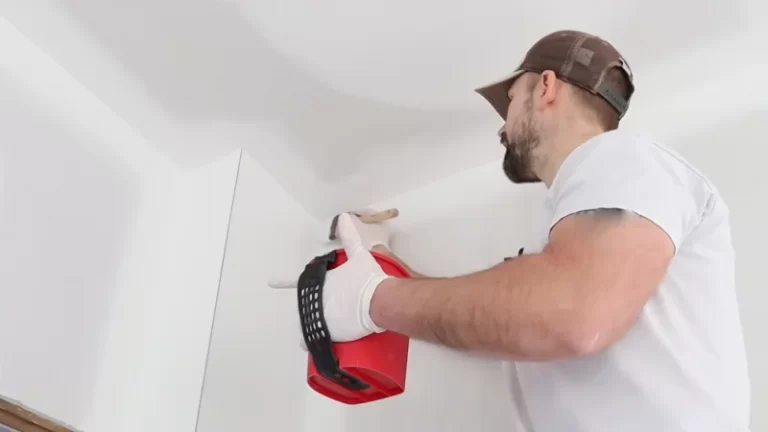Can You Plaster Over Ceiling Tiles? Your Ultimate Guide
Dated, stained, or damaged ceiling tiles can make an entire room feel old and neglected. It’s a common problem that leads many homeowners to ask: can you plaster over ceiling tiles for a smooth, modern finish? The short answer is yes, it is technically possible, but the real answer is far more complex and fraught with risks.
Simply applying plaster directly over old ceiling tiles without proper preparation is a recipe for disaster. This guide will walk you through the significant challenges, the critical safety precautions, and the meticulous step-by-step process required for a successful outcome, as well as introduce you to safer, more reliable alternatives.
You'll Learn About
Why Plastering Over Ceiling Tiles is a Major Challenge
Before you pick up a trowel, understanding the inherent difficulties is crucial. Ceiling tiles, especially older acoustic or fiberboard types, were never designed to be a substrate for a heavy, wet material like plaster. Ignoring these challenges can lead to cracking, sagging, and even complete ceiling failure.
The Critical Issue of Adhesion and Surface Preparation
Most ceiling tiles have a surface that is not conducive to plaster adhesion. They can be coated with paint, vinyl, or have a textured, porous surface. Plaster applied directly to such surfaces will not form a strong bond, leading to delamination and peeling over time. Proper priming with a high-adhesion bonding primer is non-negotiable.
Structural Integrity and Weight Concerns
Acoustic and fiberboard ceiling tiles are lightweight by design. Plaster, on the other hand, is heavy. A layer of plaster can add significant weight that the tiles and their installation method (often glue or staples) were never meant to support. This excess weight can cause the tiles to pull away from the ceiling joists, creating a dangerous sagging situation.
Dealing with Seams and Grid Lines
The grid pattern of ceiling tiles is one of the main aesthetic issues homeowners want to eliminate. However, these seams are points of movement. Without proper treatment, the expansion and contraction of the tiles will cause “ghost lines” or cracks to appear through the new plaster, perfectly outlining the tiles you tried to hide.
The Asbestos Elephant in the Room
This is the most important consideration. If your home was built or renovated before the late 1980s, your ceiling tiles have a high chance of containing asbestos. Materials like acoustic tiles, often 12×12 or 24×24 inches with a soft, fibrous texture, frequently used asbestos for its fire-retardant and insulating properties. Disturbing these tiles by sanding, screwing, or plastering can release dangerous asbestos fibers into the air, posing a severe health risk.
Before proceeding with any project that involves older ceiling tiles, you must have them tested by a certified professional. Do not attempt to identify them visually, as it’s impossible to be certain without lab analysis. If asbestos is present, covering them is not a DIY job; professional abatement or encapsulation is required.
A Step-by-Step Guide to Plastering Over Ceiling tiles (When It’s Safe)
If you have confirmed your tiles are asbestos-free and you are prepared for a labor-intensive project, follow these steps meticulously. Skipping any step will compromise the integrity and appearance of your finished ceiling.
Step 1: Room Preparation and Safety
Begin by clearing the room of all furniture. Cover the entire floor with heavy-duty drop cloths. Use painter’s tape and plastic sheeting to protect the walls. Wear safety glasses and a dust mask throughout the entire process to protect yourself from dust and debris.
Step 2: Reinforce Every Single Tile
This is the most critical step for structural stability. You cannot rely on the original adhesive or staples. You must mechanically fasten every tile to the ceiling joists above. Use a stud finder to locate the joists and then drive drywall screws through each tile and into the joist. Use at least two screws per tile for smaller tiles, and more for larger ones, ensuring they are securely anchored.
Step 3: Create a Unified Surface by Taping the Seams
To prevent the tile grid from showing through, you must treat the seams like you would with new drywall. Apply fiberglass mesh tape over every seam between the tiles. This tape will provide the reinforcement needed to prevent cracks from forming as the tiles subtly shift.
Step 4: Apply a High-Adhesion Bonding Primer
Do not use standard wall primer. You need a specialized bonding primer designed to adhere to difficult surfaces. Products like Zinsser Gardz or Kilz Adhesion are excellent choices. Apply a thorough, even coat of primer to the entire ceiling surface, including over the mesh tape, and allow it to dry completely according to the manufacturer’s instructions. This creates the “grip” your plaster needs to bond securely.

Step 5: The Skim Coat Application – Multiple Thin Layers are Key
The goal is to apply a skim coat, not a thick layer of plaster. Use a lightweight joint compound for this process. The secret to a smooth, durable finish is to apply two or three very thin coats rather than one thick one. A thick coat is not only heavier but also more prone to cracking as it dries.
Using a drywall trowel, apply your first thin coat over the entire ceiling. Let it dry completely. After it’s dry, scrape off any high spots or ridges before applying the next coat.
Step 6: Sanding and Finishing for a Professional Look
After your final coat has dried for at least 24 hours, it’s time to sand. Use a pole sander with fine-grit sandpaper (120-150 grit) for a smooth, even finish. Proper sanding is key to hiding imperfections and achieving a professional look. Be sure to wear your dust mask and eye protection, as this step creates a lot of fine dust.
Step 7: Priming and Painting Your New Ceiling
Once the ceiling is sanded and wiped clean of all dust, apply a coat of high-quality drywall primer. This will seal the new plaster and ensure an even paint finish. After the primer is dry, you can finally paint your new, smooth ceiling with the color of your choice.
Alternatives: Safer and More Reliable Ways to Hide Ceiling Tiles
Given the risks and labor involved in plastering, it is wise to consider alternatives. These methods are often more suitable for DIYers and can provide a more stable, long-lasting result.
Drywall Overlay: The Gold Standard
One of the best solutions is to install a new layer of thin (1/4 inch or 3/8 inch) drywall directly over the existing ceiling tiles. This method involves screwing the drywall sheets through the tiles and directly into the ceiling joists. While it requires lifting heavy sheets, it creates a brand new, perfectly stable surface that is ideal for finishing and eliminates all the problems associated with tile movement and plaster adhesion.
Beadboard or Wood Planking
For a more decorative look, consider installing beadboard panels or tongue-and-groove wood planks. These can be attached to furring strips that are first secured to the ceiling joists. This approach adds character and warmth to a room and is an excellent way to cover an old ceiling.
Modern Decorative Panels
There are many modern ceiling solutions available today. Lightweight PVC or tin-look tiles can be glued directly over the existing tiles, offering an instant transformation with minimal mess. While some homeowners consider using peel-and-stick products, it’s important to understand the risks; a detailed look at whether you can you use peel and stick tiles on the ceiling reveals why this might not be the best choice for every situation.
Considering a broader renovation? Thinking about how your ceiling project fits in with other updates, like installing a fully enclosed shower in a bathroom, can help you plan a cohesive design for your home.
| Method | Difficulty | Approximate Cost | Best For |
|---|---|---|---|
| Plastering Over Tiles | High | Low to Moderate | Experienced DIYers on a tight budget where tiles are perfectly secure. |
| Drywall Overlay | Moderate to High | Moderate | Achieving the most durable, flat, and professional-looking smooth ceiling. |
| Beadboard/Wood Planks | Moderate | Moderate to High | Creating a decorative, rustic, or traditional look. |
| Decorative PVC Tiles | Low | Low to Moderate | A fast, easy, and stylish update with minimal demolition or mess. |
Common Mistakes to Avoid at All Costs
Many DIY projects go wrong because of simple, avoidable errors. When it comes to plastering over ceiling tiles, these mistakes can ruin the entire project.
- NEVER skip reinforcing the tiles. Glue alone will fail under the weight of plaster.
- DO NOT use the wrong primer. Standard PVA or paint primer will not create a strong enough bond.
- AVOID applying plaster too thickly. This adds unnecessary weight and leads to cracking.
- NEVER ignore the risk of asbestos. Always test tiles in homes built before the late 1980s.
- DON’T forget to tape the seams. Untaped seams will inevitably show through as visible cracks.
Small details in any home project can make a big difference. Even something as simple as misplacing a remote control can be a frustrating setback. If you ever find yourself in that situation, knowing what to do when you lose your fireplace remote can save you a headache.
Is Plastering Over Ceiling Tiles Really Worth It?
Plastering over ceiling tiles can be a successful project, but only if executed with extreme care, thorough preparation, and an understanding of the risks. It demands patience and a significant amount of physical effort.
For most homeowners, the risks of cracking, sagging, and potential asbestos exposure outweigh the benefits. Alternatives like covering the ceiling with a new layer of drywall are often safer, more reliable, and provide a superior, longer-lasting finish. Ultimately, choosing the right method depends on your budget, your DIY skill level, and the condition of your existing ceiling.

